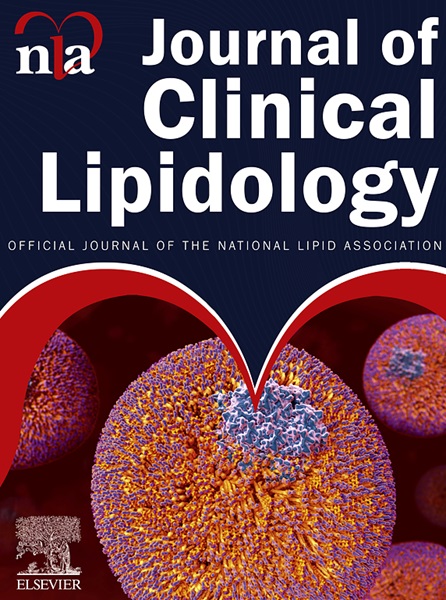心血管疾病患者从强化降脂治疗中获益的时间。
IF 3.6
3区 医学
Q2 PHARMACOLOGY & PHARMACY
引用次数: 0
摘要
背景:在2010年新型药物(9型蛋白转换酶亚基酶/kexin抑制剂[PCSK9i]和依泽替米贝[ezetimibe])问世之前和之后,强化降脂治疗在减少已确诊心血管疾病(CVD)患者主要不良心血管事件(MACE)方面的临床获益时间尚不明确:评估强化降脂治疗的获益时间(TTB):研究人员系统检索了评估强化降脂疗法的随机对照试验。主要结果是MACEs。利用重建的个体参与者数据,对Weibull生存曲线进行拟合,以估计特定绝对风险降低阈值(0.002、0.005和0.01)下的TTB:结果:共确定了七项试验,随机抽取了 92180 名年龄在 58.2 岁至 63.6 岁之间的成年人。每 100 例患者中需要 19.6 个月的强化降脂治疗 TTB(95 % 置信区间 [CI]:12.3 至 31.4)才能预防 1 次 MACE。2010 年以前,当他汀类药物是唯一选择时,高强度他汀类药物治疗的 TTB 为 15.2 个月(95 % 置信区间 [CI]:6.52 至 35.5)。2010 年后,在他汀类药物治疗的基础上,以 PCSK9i 为基础、以依折麦布为基础的强化降脂治疗的 TTB 分别为 17.7 个月(95 % CI:12.2 至 25.6)和 47.3 个月(95 % CI:20.4 至 110):在当代实践中,在他汀类药物治疗的基础上,基于 PCSK9i 和基于依折麦布的强化降脂治疗分别需要 17.7 个月和 47.3 个月的 TTB,才能在 100 名已确诊心血管疾病患者中预防 1 次 MACE。在不同药物治疗方案中观察到的差异凸显了个性化治疗决策的必要性。本文章由计算机程序翻译,如有差异,请以英文原文为准。

Time to benefit of intensive lipid lowering therapy in individuals with cardiovascular disease
BACKGROUND
The timing of the clinical benefit of intensive lipid-lowering therapy in reducing major adverse cardiovascular events (MACE) in individuals with established cardiovascular disease (CVD), both before and after the advent of novel medications (proprotein convertase subtilisin/kexin type 9 inhibitor [PCSK9i] and ezetimibe) in 2010, is unclear.
OBJECTIVE
To evaluate the time to benefit (TTB) from intensive lipid-lowering therapy.
METHODS
The investigators systematically searched for randomized controlled trials evaluating intensive lipid-lowering therapy. The primary outcome was MACE. Utilizing reconstructed individual participant data, Weibull survival curves were fitted to estimate the TTB for specific absolute risk reduction thresholds (0.002, 0.005, and 0.01).
RESULTS
Seven trials randomizing 92,180 adults aged between 58.2 and 63.6 years were identified. A TTB of 19.6 months (95% CI: 12.3–31.4) of intensive lipid-lowering was needed to prevent 1 MACE per 100 patients. Before 2010, when statin was the only option, a TTB for high-intensity statin therapy of 15.2 months (95% CI: 6.52–35.5) was needed. After 2010, the TTB for PCSK9i-based, ezetimibe-based intensive lipid-lowering on a background of statin therapy was 17.7 (95% CI: 12.2–25.6) and 47.3 (95% CI: 20.4–110) months, respectively.
CONCLUSION
In contemporary practice, to prevent 1 MACE in 100 individuals with established CVD, a TTB of 17.7 and 47.3 months was needed for PCSK9i-based and ezetimibe-based intensive lipid-lowering therapy on a background of statin therapy, respectively. The observed variations across different drug regimens highlight the need for a personalized approach to treatment decisions.
求助全文
通过发布文献求助,成功后即可免费获取论文全文。
去求助
来源期刊
CiteScore
7.00
自引率
6.80%
发文量
209
审稿时长
49 days
期刊介绍:
Because the scope of clinical lipidology is broad, the topics addressed by the Journal are equally diverse. Typical articles explore lipidology as it is practiced in the treatment setting, recent developments in pharmacological research, reports of treatment and trials, case studies, the impact of lifestyle modification, and similar academic material of interest to the practitioner.
Sections of Journal of clinical lipidology will address pioneering studies and the clinicians who conduct them, case studies, ethical standards and conduct, professional guidance such as ATP and NCEP, editorial commentary, letters from readers, National Lipid Association (NLA) news and upcoming event information, as well as abstracts from the NLA annual scientific sessions and the scientific forums held by its chapters, when appropriate.

 求助内容:
求助内容: 应助结果提醒方式:
应助结果提醒方式:


